Sanitizing equipment is a vital step in home brewing, as it protects your beer from harmful microorganisms that can lead to off-flavors and spoilage. By employing effective sanitization methods, you can ensure a clean and flavorful product that is safe to enjoy. Choosing the right sanitizing tools is essential for maintaining hygiene and efficiency throughout the brewing process.

What are effective sanitizing methods for home brewing?
Effective sanitizing methods for home brewing ensure that all equipment is free from harmful microorganisms. This is crucial for producing high-quality beer and preventing off-flavors or spoilage.
Boiling water
Boiling water is a straightforward and effective method for sanitizing brewing equipment. By immersing items in boiling water for at least 10 minutes, you can kill most bacteria and yeast. However, this method may not be suitable for all materials, such as plastics that could warp or melt.
For best results, ensure that all surfaces are fully submerged and avoid overcrowding the pot. Allow the equipment to air dry on a clean surface after boiling to prevent recontamination.
Chlorine-based sanitizers
Chlorine-based sanitizers, such as bleach, are effective at killing a wide range of microorganisms. A common dilution is one tablespoon of bleach per gallon of water, but it’s essential to rinse thoroughly afterward to remove any residual chlorine that could affect flavor.
While affordable and readily available, chlorine can corrode some metals and may leave a strong odor. Always use in a well-ventilated area and wear gloves to protect your skin.
Star San solution
Star San is a popular no-rinse sanitizer that works by creating a foam that clings to surfaces, killing bacteria and wild yeast. It is effective at low concentrations, typically around 1 ounce per 5 gallons of water.
One of the advantages of Star San is its quick action; it only requires a contact time of about 1-2 minutes. Make sure to use distilled or filtered water to avoid any mineral interference that could affect its efficacy.
Iodophor sanitizers
Iodophor is another effective sanitizer that uses iodine to eliminate microorganisms. It typically requires a dilution of about 1 ounce per 5 gallons of water and has a contact time of around 2 minutes.
Unlike chlorine, iodophor does not leave a strong odor and is less likely to affect the flavor of your brew. However, it can stain some materials, so handle with care and ensure thorough rinsing if necessary.
Peracetic acid
Peracetic acid is a powerful sanitizer that is effective against a broad spectrum of pathogens. It is typically used at a concentration of 0.2-0.5% in water and requires a contact time of about 1-5 minutes.
This sanitizer is particularly useful in commercial brewing settings but can also be employed at home. It breaks down into harmless byproducts, making it safe for food contact surfaces. Always follow the manufacturer’s instructions for dilution and contact time to ensure effectiveness.
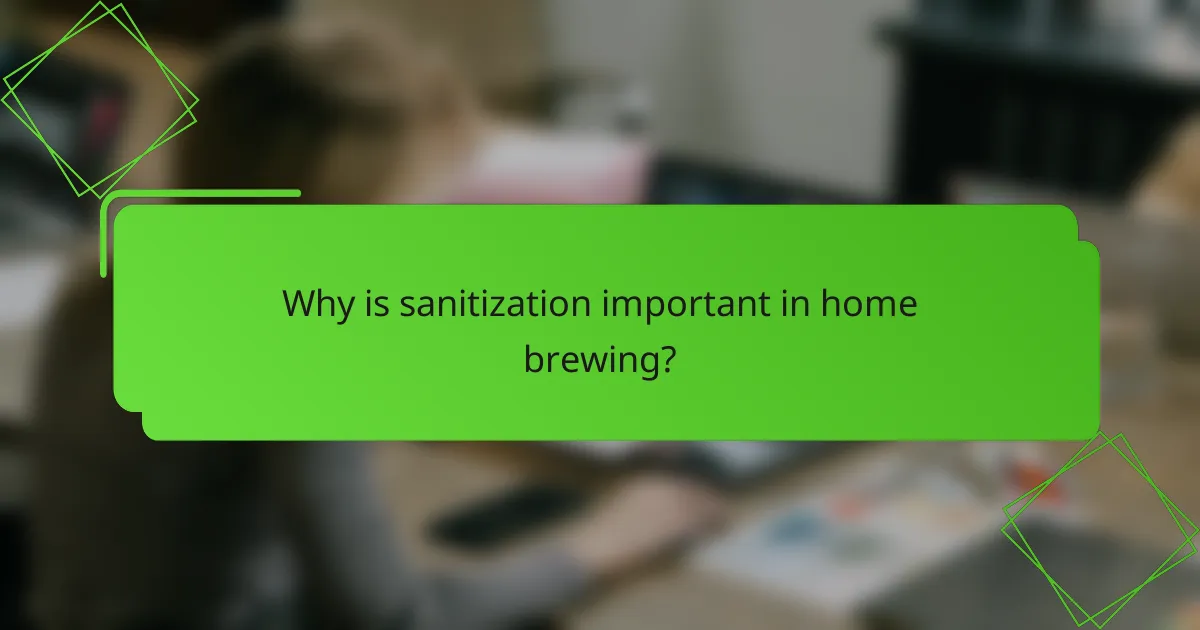
Why is sanitization important in home brewing?
Sanitization is crucial in home brewing because it prevents unwanted microorganisms from contaminating the beer. Effective sanitization ensures that the brewing process yields a clean, flavorful product that is safe to consume.
Prevents contamination
Contamination can occur at any stage of the brewing process, from equipment to ingredients. Microorganisms like bacteria and wild yeast can spoil the beer, leading to undesirable flavors and aromas. Using proper sanitization methods, such as soaking equipment in a sanitizing solution, can significantly reduce the risk of contamination.
Common sanitizers include iodine-based solutions, chlorine dioxide, and no-rinse options like Star San. Each has its own application method and contact time, so it’s essential to follow the manufacturer’s instructions for effective results.
Ensures quality of beer
Sanitization directly impacts the quality of the final product. Clean equipment allows the desired yeast to thrive, producing the intended flavors and aromas. If equipment is not properly sanitized, it can introduce off-flavors that compromise the overall quality of the beer.
To ensure quality, always sanitize fermenters, bottles, and any tools that come into contact with the beer. A good practice is to sanitize immediately before use to minimize exposure to contaminants.
Reduces off-flavors
Off-flavors in beer often stem from contamination by unwanted microorganisms. These can produce compounds that lead to sourness, bitterness, or other undesirable tastes. By maintaining strict sanitization practices, brewers can minimize the chances of these off-flavors occurring.
Regularly inspect and clean your brewing equipment, and consider conducting taste tests to identify any off-flavors early in the brewing process. If you notice any issues, reassess your sanitization methods and adjust as necessary to maintain the integrity of your beer.
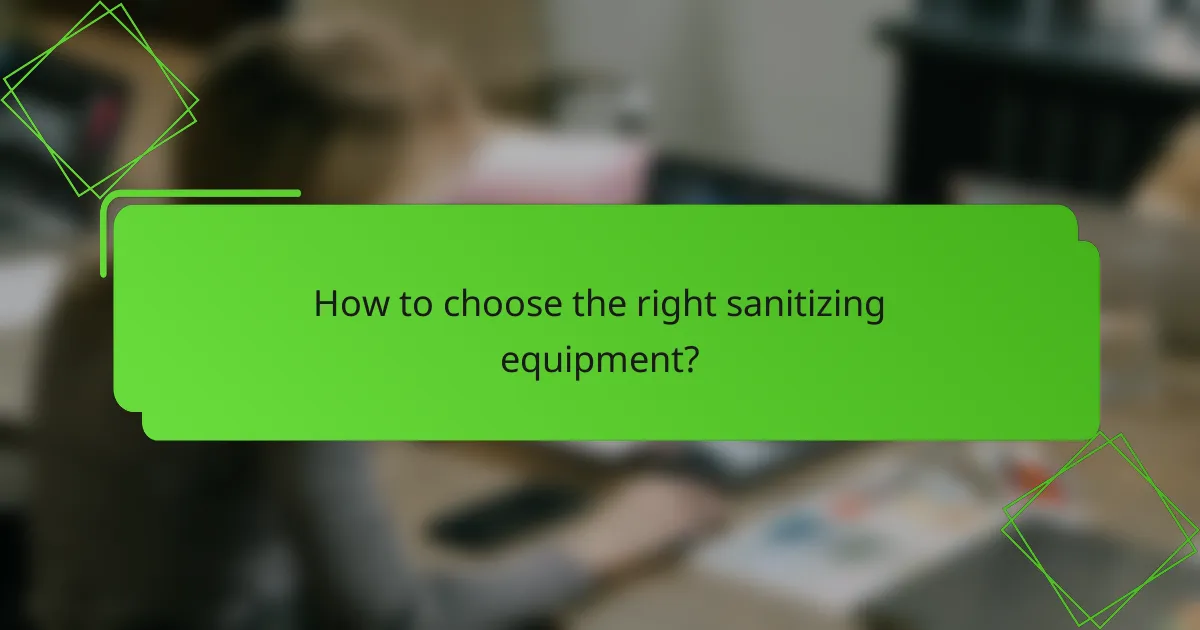
How to choose the right sanitizing equipment?
Selecting the right sanitizing equipment is crucial for effective home brewing. Consider factors such as size, effectiveness, and ease of use to ensure your brewing process remains hygienic and efficient.
Consider equipment size
The size of your sanitizing equipment should match your brewing scale. For small batches, a compact sanitizer like a spray bottle may suffice, while larger operations might require bulk sanitizers or immersion tanks.
Evaluate your brewing setup and storage space to determine the most practical size. A good rule of thumb is to choose equipment that can handle at least double your typical batch size to accommodate overflow and ensure thorough sanitization.
Evaluate sanitizer effectiveness
Not all sanitizers are created equal; effectiveness varies based on the type of sanitizer and the microorganisms they target. Common options include iodine-based, chlorine-based, and no-rinse sanitizers, each with unique strengths.
Check the manufacturer’s guidelines for contact time and dilution ratios. For instance, no-rinse sanitizers often require shorter contact times, making them convenient for quick sanitization. Aim for products that meet recognized standards, such as those approved by the EPA.
Assess ease of use
Ease of use is a significant factor when selecting sanitizing equipment. Look for products that are straightforward to apply and require minimal preparation. For example, ready-to-use sprays can save time compared to those needing mixing.
Consider the cleaning process as well. Some sanitizers may leave residues that require additional rinsing, while no-rinse options simplify the workflow. Always read user reviews to gauge how other brewers have found the usability of specific products.
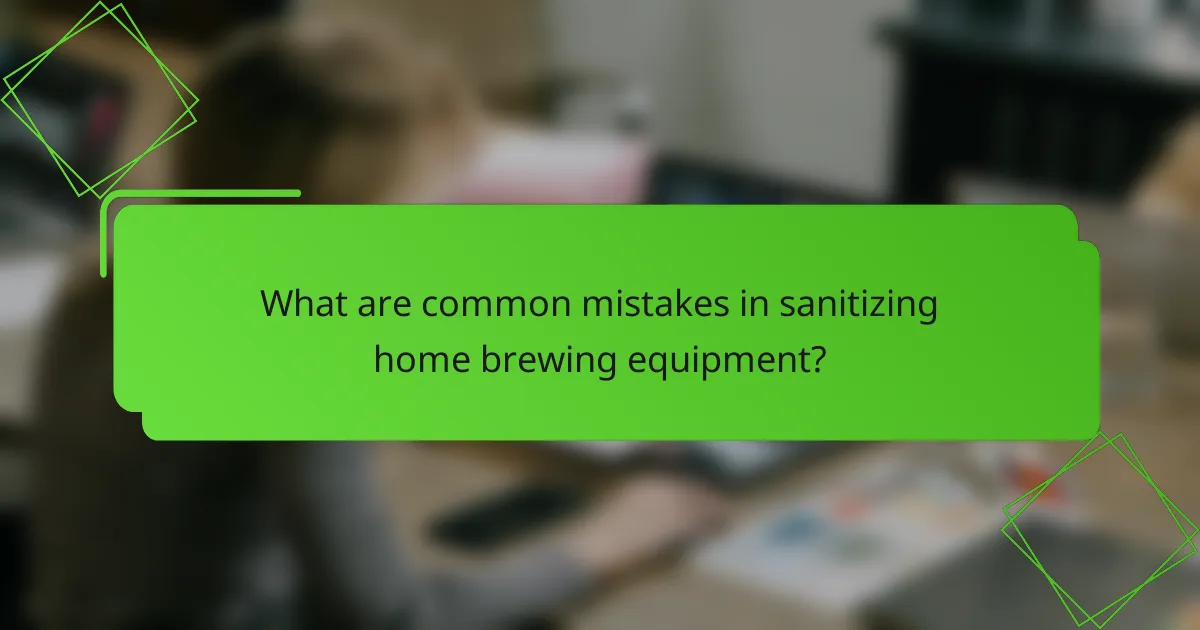
What are common mistakes in sanitizing home brewing equipment?
Common mistakes in sanitizing home brewing equipment include inadequate rinsing, using expired sanitizers, and skipping sanitization steps. These errors can lead to contamination, spoilage, and ultimately ruined batches of beer.
Inadequate rinsing
Inadequate rinsing can leave behind residues from sanitizers that may affect the flavor and quality of your brew. After sanitizing, it’s crucial to thoroughly rinse equipment with clean water to ensure no chemical traces remain. Aim for a rinse that removes all visible sanitizer, typically using a few liters of clean water.
To avoid this mistake, consider using a spray bottle filled with clean water to rinse hard-to-reach areas. Always check the manufacturer’s instructions for your sanitizer, as some may require specific rinsing protocols.
Using expired sanitizers
Using expired sanitizers can significantly reduce their effectiveness, increasing the risk of contamination. Sanitizers have a shelf life, and using them past their expiration date can lead to poor sanitization results. Always check the expiration date before use and replace any expired products.
For best results, store sanitizers in a cool, dry place and keep them sealed when not in use. If you’re unsure about the effectiveness of a sanitizer, consider performing a simple test to confirm its potency before proceeding with your brewing process.
Skipping sanitization steps
Skipping sanitization steps can compromise the entire brewing process, leading to unwanted bacteria and wild yeast. Each step in the sanitization process is designed to eliminate potential contaminants, so it’s essential to follow them meticulously. Create a checklist of all sanitization steps to ensure nothing is overlooked.
Common steps include cleaning equipment before sanitizing, allowing sufficient contact time for the sanitizer, and ensuring all surfaces are covered. By adhering to these steps, you can significantly reduce the risk of spoilage and ensure a successful brewing experience.
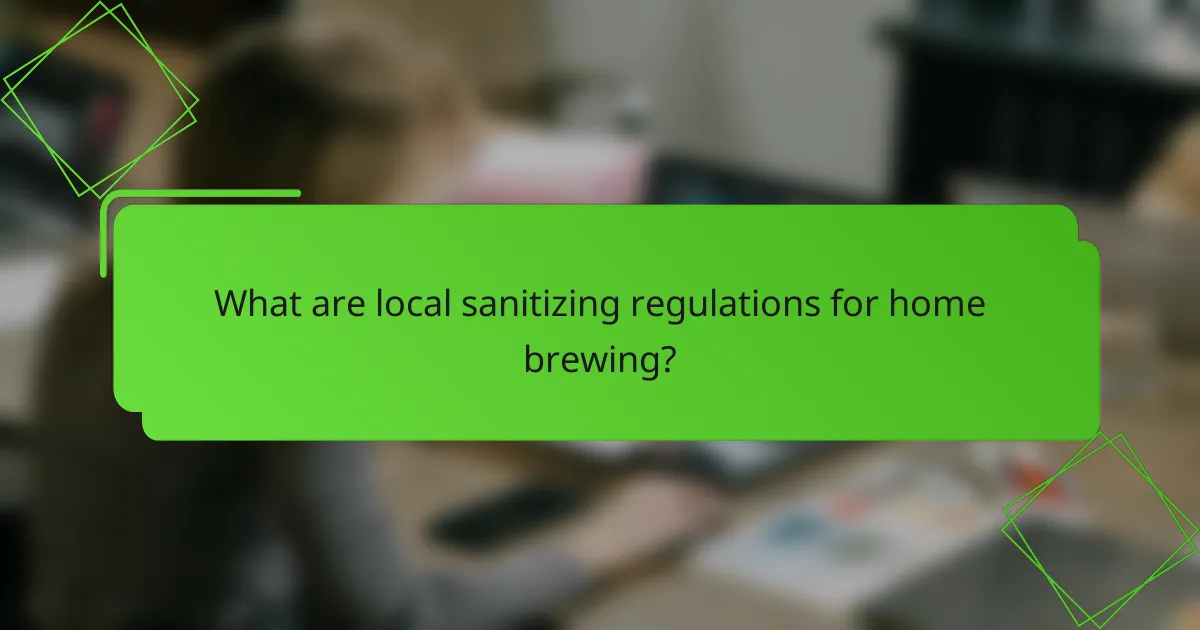
What are local sanitizing regulations for home brewing?
Local sanitizing regulations for home brewing vary by region and often include guidelines on equipment cleanliness and sanitation methods. Home brewers must adhere to these regulations to ensure product safety and quality, which may involve specific sanitizing agents and procedures approved by local authorities.
State-specific guidelines
Each state in the U.S. may have its own set of guidelines regarding home brewing sanitation. For example, some states require that all brewing equipment be sanitized with approved chemicals, while others may allow the use of hot water or steam. It’s crucial to check your state’s alcohol beverage control board for specific requirements that apply to home brewers.
Additionally, some states impose limits on the amount of alcohol that can be produced for personal use, which may indirectly affect sanitizing practices. For instance, states with lower production limits might have less stringent sanitation regulations compared to those allowing larger batches.
Local health department requirements
Local health departments often enforce regulations that impact home brewing, particularly in urban areas. These requirements may include regular inspections of home brewing setups, especially if the product is intended for sale. Compliance with local health codes is essential to avoid fines or shutdowns.
Home brewers should contact their local health department to understand any specific sanitation practices they must follow. This may include using food-grade sanitizers and maintaining a clean brewing environment to prevent contamination.
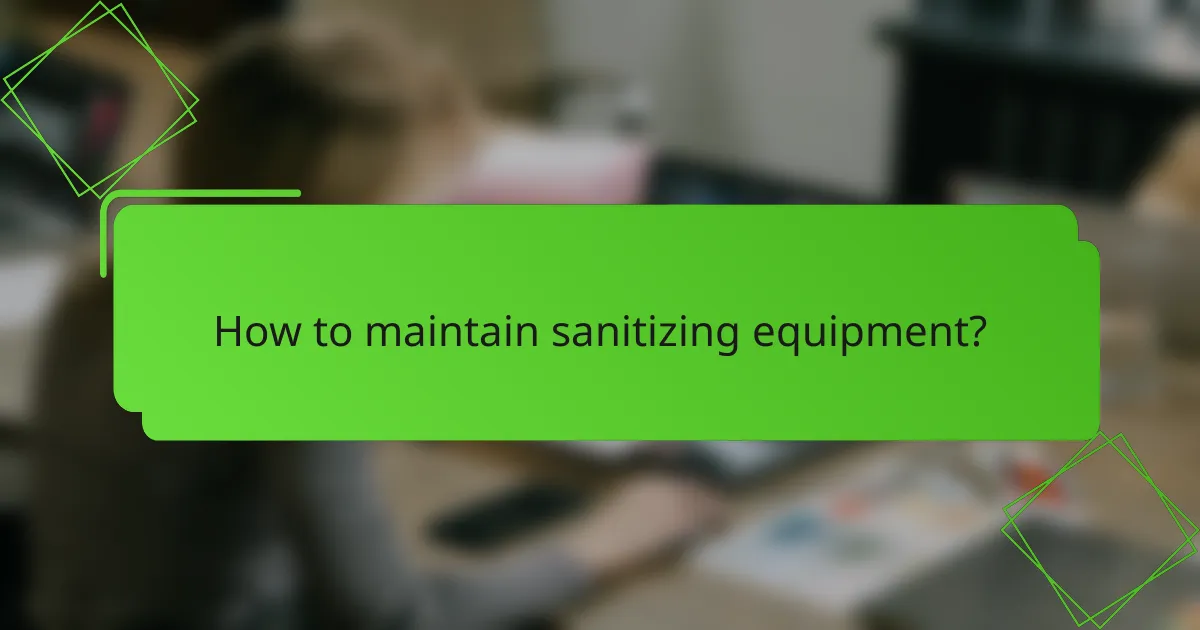
How to maintain sanitizing equipment?
Maintaining sanitizing equipment is crucial for effective home brewing. Regular cleaning and proper storage ensure that your equipment remains free from contaminants, preserving the quality of your brews.
Regular cleaning practices
To maintain sanitizing equipment, establish a routine cleaning schedule. After each use, rinse your equipment with hot water to remove residues, then use a suitable cleaning solution to eliminate any remaining contaminants. Pay special attention to hard-to-reach areas where residues may accumulate.
Consider using a brush or cloth specifically designed for brewing equipment to ensure thorough cleaning. For stubborn stains or buildup, soaking the equipment in a cleaning solution for a short period can be effective.
Choosing the right sanitizers
Selecting the right sanitizers is essential for effective sanitation. Common options include iodine-based solutions, chlorine bleach, and no-rinse sanitizers. Each has its pros and cons, such as effectiveness against various microorganisms and the need for rinsing.
For home brewers, no-rinse sanitizers are often preferred due to their convenience. However, ensure you follow the manufacturer’s instructions regarding dilution and contact time for optimal results.
Storage and handling tips
Proper storage of sanitizing equipment is vital to maintain its effectiveness. Store your equipment in a clean, dry area away from direct sunlight and contaminants. Use airtight containers for any cleaning solutions to prevent degradation.
Always handle sanitizing equipment with clean hands or gloves to avoid introducing new contaminants. Regularly check for any signs of wear or damage, as this can affect the performance of your sanitizing equipment.



